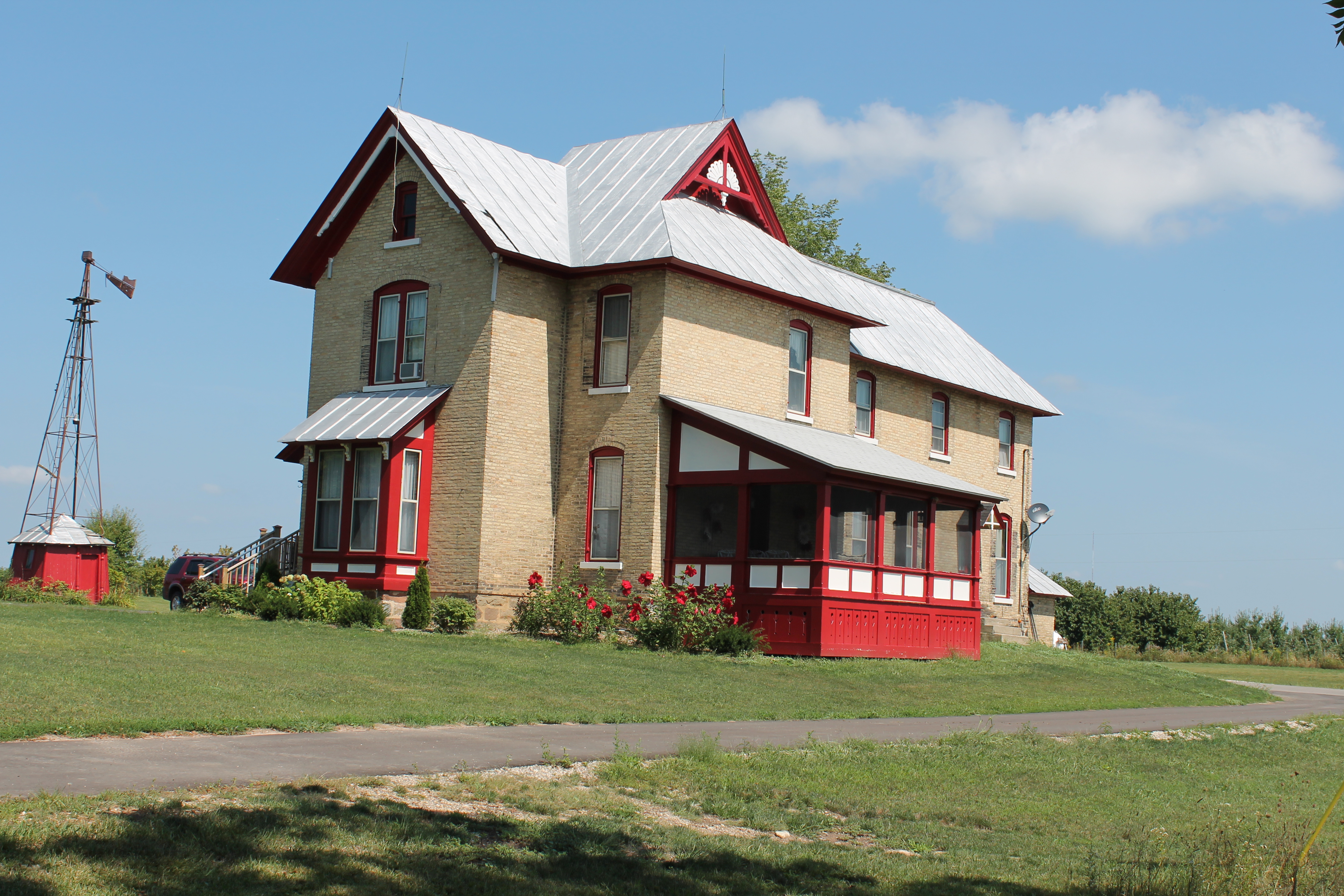Meet local entrepreneurs, owners of Frozen Creek Floral & Farm

Belmont couple preserves unforgettable memories on family farm
Sitting comfortably in their rustic floral design shop immersed in the scents of dried flowers, Paul Geer and Ruth Smiley talk about their love for flowers. The ancient family cat Mr. BC looks over Paul’s shoulder cautiously, while eight months old pup Bailey sniffs around restlessly checking out the guest.
The Frozen Creek Florals enterprise is located on a 25-acre farm including the stucco farmhouse, barns and greenhouses. The farm is the oldest farm in Cannon Township, Michigan according to the local historical society, and it was settled by the Rood family somewhere between 1800s and 1836. It is surrounded by giant maple, walnut, apple and pine trees. The home is full of country, Victorian, southwest and contemporary arrangements adorned by wreaths and swags, along with bunches of dried herbs, everlasting flowers and blends of potpourri.
The farmland contains many rocks and boulders as it was formed from a slow curve in the river. The glaciers from Canada pushed the boulders down and after a natural freeze thaw, the rocks precipitated out of the river, explained Paul, a geologist turned florist. That is where the name for the farm comes from, from the frozen Bear Creek.
The wall behind Paul and Ruth is decorated with a dried herb wreath and a pinned up note that says: “The entrepreneur always searches for change, responds to it and exploits it as an opportunity…..” Pete Drucker.
The couple has come a long way since Paul, who grew up on a farm in West Virginia, started peddling flowers to the ladies club at the church, and hauling manure.
“That’s how my business budded,” Paul laughed, no pun intended.
Later, Paul discovered that if he brought flowers to girls in high school, he’d get lucky.
“And in university I got even luckier,” Paul said.
During his service as a captain in the army, Paul sold flowers at local markets on weekend passes.
The boom for bouquets and home decor came in the late 1970s as Paul was going to new art shows and flea markets around Michigan. As soon as he got out of the army, Paul established Frozen Creek Florals in 1978. He sold flowers on the arts and crafts circuits around the state.
Paul saw an opportunity when freeze dry flowers were big in the mid 1980s. He purchased freezing machines from Northstar, a company based in Minnesota. Together with 20 other business people, Paul formed the International Freeze Dry Floral Association in 1987, and became its president.
The expectations were high at $7 per frozen dried flower, but the hyperbole didn’t come true. And today less than 50 manufacturers of frozen dried flowers remain in the county, according to Paul.
“We’re the only ones left in Michigan,” he said. “I stayed home-based since I wasn’t set up for mass production.”
But, the beautiful preserved bouquets mounted in glass cases that brides and their entourages will cherish forever come at a price.
“It’s a pretty energy consumptive process,” said Paul.
As Paul led the way to the barn that houses his four freeze drying machines, he talked about the lengthy complex process of preserving a beautiful wedding or life celebration bouquet.
First, in order to preserve a bouquet in its original beauty, it has to come in to the farm as soon as possible after the wedding. Here, Ruth disassembles the bouquet into individual flowers that our frozen solid as soon as the machine gets full. Under temperatures minus -60 to -70, the flowers are frozen without going through a liquid stage. This process is called sublimination during which gas turns into ice crystals in a funnel below the machine.
“What we get in is what comes out,” said Paul.
The drying time is approximately three months since the machine holds all sorts of different flowers; from the easiest to dry roses to the most difficult orchids and other wax flowers. Paul prefers to air on the side of caution so he makes sure that all the flowers are dried before he opens the machine. It costs $500 to $600 per cycle on the machine. In summer time, Paul runs two to three machines at once.
“Every keepsake I have to treat as it is my keepsake,” he said.
One cylinder-like machine can hold up to 75 wedding bouquets. After freeze drying, the flowers are coated with a chemical solution so they do not shatter. The coating in 15 to 18 gallon batches is done within a day. Paul has a U.S. patent on the rubber solution. Then, Ruth re-assembles the bouquet to its original beauty and mounts it inside a conservation acrylic dome. Paul calls it, “the fresh flower mentality.”
“If you want the perpetuity of the flowers, the bouquet needs to be enclosed,” Paul said. “The dome is a UV inhibitor much like the ones used in museums.”
The price for freeze drying depending on the size of the bouquet ranges from $150 to $185, and for the acrylic cases from $90 to $400.
“A big cascading bouquet with different heights is going to cost more than a smaller bouquet,” said Ruth.
As we enter Ruth’s “Keepsake Room” with displayed conservation domes on the walls, I step back in awe. I could not believe what I saw.
“This is incredible.”
Immortal bouquets sealed in domes, that protect them from moisture, seemed to breathe life.
“We do as much post event business for weddings, as for funerals,” said Ruth. “We call them life celebrations.”
Regardless the labeling, when standing in the “Keepsake Room” it is hard to tell a preserved wedding bouquet from a casket spray. Both equally bring back beloved memories that only a flower can capture in her petals, in her delicate structure and bold character accentuated by unique combinations of colors.
Ruth pointed an outstanding piece from Katie Bush’s 2012 June wedding . The blue and purple bouquet was re-assembled after freeze drying and coating, and placed in a 16 by 20 inch oval black frame with an acrylic dome.
The very much alive bouquet consisted of lavender stock, purple lisianthus, dendrobium orchids, blue delphinium, and peacock feathers.
So how did this fairytale Geer-Smiley enterprise with love for flowers come into existence?
Long before the Internet, when Ruth worked for Bridal Affair, a store by Woodland Mall, she filled out a profile in the dating magazine at the store.
Well, lucky enough Paul answered the dating challenge with five different personalities, as he calls it.
“Ruth answered four of them,” said Paul. “I had a friend statistician, and he said dating is a game of numbers.”
After they met at Jose Babuska now the Rio Grande, Paul had delivered a dozen roses to Ruth at the Roger’s Department store.
“That cheap bastard for being a florist,” said Ruth when she got the roses.
Next thing, he brought her in person three foot tall walking stick roses.
“Now, I got him trained,” laughed Ruth.
They got married on a yacht in Jamaica in 1990. Paul had the dock lined with 2,000 roses from a farm in Jamaica.
So, the marriage solidified the enterprising business, and Paul in 1991 bought the current farm. But before that, Ruth worked for him as an employee and started getting her own custom orders.




















I owe all my success to my husband Ludek Pala and Word Press, they both let me fly. Thank you.
LikeLike
Thank you for the good writeup. It if truth be told was a entertainment account it.
Glance complicated to far brought agreeable from you!
However, how could we communicate?
LikeLike
Hello
You can email me at emmapalova@yahoo.com
Looking forward to hearing from you.
Emma
http:// emmapalova.com
LikeLike
Bonsoir Emma,
I appreciate enormously your glowing comments about my pictures and would be honoured to have one or more featured on your EW sites.
Kind regards
Dan
LikeLike